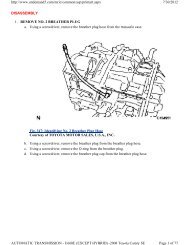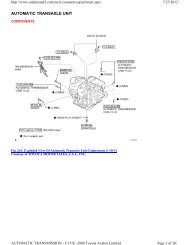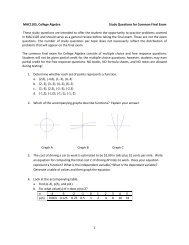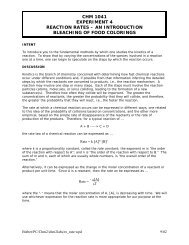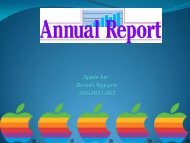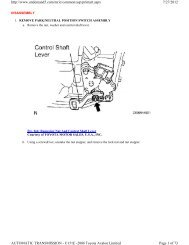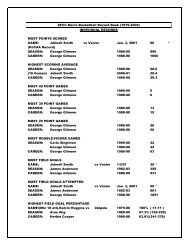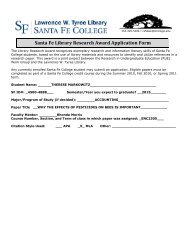Lab 8 Vertebrate homologies:Layout 1.qxd
Lab 8 Vertebrate homologies:Layout 1.qxd
Lab 8 Vertebrate homologies:Layout 1.qxd
You also want an ePaper? Increase the reach of your titles
YUMPU automatically turns print PDFs into web optimized ePapers that Google loves.
LABORATORY<br />
8<br />
Back in the 1890’s, Darwin and others proposed that natural selection allowed for the survival of<br />
some individuals over that of others. Variations in anatomical and physiological structures may have<br />
lead to this differential survival of organisms. Since these beneficial adaptations were inherited we<br />
can use the observed variations in the skeletons of vertebrates as evidence for evolution. We see<br />
important similarities as though they were variations on a basic theme. This kind of similarity due<br />
to common ancestry are called homology. In some vertebrate structures we do not observe this<br />
kind of similarity but rather commonality of function of structures which is called analogy.<br />
Skeletons of vertebrates have changed relatively slowly over time. This slow change helps reveal<br />
relationships among species since skeletons, including teeth, are often the only parts of the animal<br />
that are preserved through fossilization.<br />
In this lab we will:<br />
• Learn how to recognize different tooth types in animals and understand dental<br />
formulas.<br />
• Learn how to extract information about the diet of animals based on the tooth<br />
type and structure of the teeth<br />
• Learn the major parts of the mammalian skeleton<br />
• Use your knowledge of evolutionary relationship to find similarities and<br />
differences among the structures of present day animals<br />
ADAPTATION OF TEETH<br />
<strong>Vertebrate</strong> Homologies: Evidence<br />
for evolution?<br />
Begin by examining the human skull and comparing its teeth with that diagram shown.<br />
Teeth are adapted for particular eating habits. Notice the four type of teeth in the diagram. Most<br />
mammals are heterodontic, having teeth of different shapes and sizes while other animals are<br />
homodontic, having teeth that are the same shape and size (example: dolphins).<br />
8-1
Incisors: Well developed chisel-shaped teeth with a<br />
cutting edge. These teeth are primarily used for obtaining<br />
food.<br />
Canines: Conical shaped teeth that are adapted for<br />
stabbing, holding, or tearing.<br />
Premolars: Teeth that contains several points (cusps)<br />
for tearing and slicing<br />
Molars: Largest of the teeth that may contain points in<br />
carnivores. In herbivores they are usually flat and<br />
adapted for grinding cellulose in plant cell walls. Both<br />
the premolars and molars are used primarily for chewing.<br />
The dental formula is a shorhand notation expressing<br />
the number of each kind of tooth in the jaws. Teeth in<br />
the upper jaw are noted above the line; those in the lower<br />
jaw are noted below the line. Using the human as an<br />
example, the dental formula would be written as such:<br />
incisors(4)-canine(2)-premolars(4)-molars(6) in upper jaw = 16<br />
incisors(4)-canine(2)-premolars(4)-molars(6) in lower jaw = 16<br />
Total number of teeth = 32<br />
The basic design of teeth and jaws in mammals is similar. However, there are adaptations based<br />
on the primary food source of the mammals.<br />
Omnivores, such as pigs and bears and humans, may eat anything, including vegetation and meat.<br />
The molars and premolars are adapted for both grinding and crushing.<br />
Carnivores, such as cats, dogs, and wolves are meat eaters. They have teeth that are welldifferentiated<br />
and adapted for securing and eating flesh. The canines are long and sharply-pointed<br />
for seizing and tearing prey. The premolars and molars are flattened laterally and have sharp edges<br />
for cutting. The skull is also adapted for the attachment of strong muscles required for meat eating.<br />
Insectivores, such as moles, some species of bats, shrews, and hedgehogs do not have well<br />
differentiated teeth. All of the teeth are short and have sharp points (cusps).<br />
Herbivores, such as cows and deer are plant eaters. The incisors are flat and sharp for cutting off<br />
vegetation or, in the case of browsers, the upper incisors may be absent. The canine teeth may also<br />
be absent in herbivores, leaving a space between the incisors and the cheek teeth (premolars and<br />
molars). The cheek teeth are broad and flat to provide a large surface area for grinding and mashing<br />
8-2
plants. There are many varieties of herbivores. They include grazers such as sheep, cows, and<br />
horses that feed on grasses, gnawers such as rats, beavers, and rabbits that feed on hard plant<br />
materials like seeds and bark, and browsers such as deer, elephants, and giraffes, which eat low<br />
shrubs and trees.<br />
COMPARISON OF ANIMAL SKULLS<br />
Examine the skulls of the animals available in the laboratory. Choose four different skulls, recognize<br />
the adaptations of each skull, infer the diet, and determine the dental formula. Record your findings<br />
in the following table. For each of the animal skulls your instructor may direct you to use your<br />
textbooks or additional resources in the laboratory to find the scientific and common name of<br />
each animal you choose.<br />
****Circle the animal you investigate<br />
Table 9-1: Dental formula data table<br />
Number of teeth type in the upper &<br />
lower jaw<br />
Species**** Incisors Canines Premolars<br />
(bicuspids)<br />
Homo sapiens<br />
(humans)<br />
Rabbit<br />
Beaver<br />
Cow<br />
Horse<br />
Deer<br />
Dog<br />
Cat<br />
Raccoon<br />
Mole<br />
Small Bat<br />
Shrew<br />
4<br />
4<br />
2<br />
2<br />
4<br />
4<br />
8-3<br />
Molars<br />
Diet Dental Formula<br />
(tricuspids)<br />
6<br />
6<br />
Ominvore<br />
4-2-4-6 = 16<br />
4-2-4-6 = 16
ADAPTATION FOR LOCOMOTION<br />
One of the distinquishing characteristics of animals is their ability to move independently within<br />
their environment. Locomotion, movement from one place to another, is an essential function<br />
in animal life. <strong>Vertebrate</strong>s have adapted to the various barriers to locomotion in their<br />
environment so that they can perform their daily activities. There are three basic types of<br />
locomotion that are observed in animals.<br />
In appendicular movement, legged locomotion, the body of the animal achieves motion by<br />
the movement of its appendicular skeleton (see diagram of the human skeleton). The animal<br />
uses muscles to move the appendages forward or backward in order to achieve locomotion.<br />
Important aspects of legged locomotion are stance (the way the body is supported by the legs),<br />
the number of legs, and the shape of the foot.<br />
There are also many forms of gaits which are ways of moving the legs in order to move such as<br />
walking, running, or hopping. Digitigrades are animals that stand and walk on their digits<br />
(toes/fingers). These animals include cats, dogs, and wolves. Because of the small footprint of<br />
the limbs they are for the most part faster and quieter than other types of animals.<br />
Unguligrades are animals that walk on the “tips” of their toes. These tips correspond to the<br />
nails of the animal. Animals in with this type of motion include horses, cows, goats, and other<br />
hooved animals. The arrangment of the bones of the limbs of unguligrades enables them to<br />
extend their stride length and so move faster. Plantigrades walk with their metatarsals and<br />
metacarpals flat on the ground. Humans, rats, bears, and raccons are examples of plantigrades.<br />
This type of locomotion is less specialized than the previous two types of locomotion.<br />
However, some plantigrades are capable of bipedal locomotion, walking on two limbs (usually<br />
the legs) in an upright position.<br />
In axial movement such as slithering the animal uses its axial skeletal to move. Snakes, fish,<br />
and several species of limbless lizards are examples of slithering animals.<br />
In rolling movement some animals are also capable of locomotion by rolling their entire body.<br />
Species of caterpillar, salamanders, and mamamals use rolling as a defence mechanism to quickly<br />
move away from being attacked.<br />
HOMOLOGOUS VS. ANALOGOUS STRUCTURES BETWEEN<br />
SPECIES<br />
In this experiment we will examine the various skeletons in the classroom and compare the size,<br />
type, and arrangment of the bones. Using these comparisons choose one of the full skeletons in<br />
the classroom that you feel is the most different from our human model. Keep in mind that<br />
humans are considered general creatures since we have not evolved to fulfill a specific nich.<br />
Your analysis should focus on looking at the number of differences compared with the number<br />
of similarities between the type of bones, arrangement of bones, and relative size of bones<br />
8-4
etween the human and the animals you choose. A diagram of the human skeleton is<br />
provided at the end of the laboratory exercise for identification of the various types of<br />
bones.<br />
After you have analyzed your first skeleton repeat the same analysis with a different skeleton that<br />
you feel is most similar to your human model. Record your analysis on the data sheet on the<br />
following page.<br />
8-5
**Choose one animal from each category**<br />
Grazer Insectivore Carinivore Omnivore<br />
Atrributes Human ________ _________ _________ __________<br />
Type of<br />
Locomotion<br />
Plantigrade<br />
Number of Digits 5<br />
Fused Radius and<br />
Ulna<br />
Scapula (flat or<br />
elongated)<br />
Fused Tibia and<br />
Fibula<br />
Sternum<br />
Clavicles<br />
Patella present<br />
Pelvic Girdle<br />
Fused vertebrae<br />
Fused Carpals and<br />
Metatarsals<br />
TABLE 9.2 SKELETON COMPARATIVE DATA TABLE<br />
9-6
8-7





